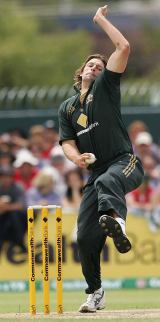
|

Bowlers like Ben Hilfenhaus are likely to have a long-term future
© Getty Images
|
|
Australia have virtually gone unchallenged at the last two World Cups. They have been all but unbeatable on their own turf since claiming the world Test crown from the West Indies in 1995. But what does the future hold now that those two highly successful marauders Shane Warne and Glenn McGrath are retired?
Let's look at the likely team in a couple of years when both Adam Gilchrist and Matthew Hayden are gone as they aren't the future, but part of the glorious past. The players likely to still form the core of the Australian side will be skipper Ricky Ponting, Michael Hussey, Michael Clarke, maybe Andrew Symonds and fast bowlers Brett Lee, Stuart Clark and Shaun Tait. It's is an impressive list but nothing like the imposing sides of the previous era.
Adding to Australia's future fragility, Lee and Clark will be aging fast bowlers and whilst Tait will mature, his action is demanding on the body and prone to producing inconsistent results. Ponting will be in the final stages of his prime, while Hussey and Symonds may still be productive players, leaving Clarke as the only batsman with his best years ahead.
Because Australia's first-class cricketers are now professional, few of the potential replacements are in the preferred 19-21 age bracket. Consequently, Australia are most likely to call on mature players like Phil Jaques, Chris Rogers, Brad Hodge and Shane Watson; all talented, but none of them destined to hold a prime position for the next ten years, as Ponting has done.
Of the younger players who are either ready or on the verge of playing international cricket, it is bowlers like Ben Hilfenhaus [an ideal replacement for Clark] and Cullen Bailey, a legspinner who could take over from Stuart MacGill in a couple of years, who are most likely to have a long-term future.
In other words, Australia are vulnerable in the post golden era after losing a gaggle of world-class players. However, there's little likelihood they'll be beaten regularly, because I don't see any opponents rising to greatness in the near future.
England is the best placed team to a be a future powerhouse because they have many good players entering their prime batting years [27-33]; Kevin Pietersen, Ian Bell, Alastair Cook and Matt Prior [if he is the real thing] are a good combination of power and precision. Nevertheless, no team can become a powerhouse without a strong attack and this is where England may falter. Monty Panesar is the genuine article, while Liam Plunkett and James Anderson have potential and are the right age to be long term wicket-takers. If Andrew Flintoff remains a bowling force and Stephen Harmison ever lives up to his potential and if Plunkett and Anderson find consistency then England, with Andrew Strauss potentially a strong leader, could be a formidable combination for a few years.
However, there are a lot of ifs and the biggest one is Harmison, who is close to being discarded into cricket's waste bin of great disappointments.
India have blown their shot at domination by not capitalising on a golden era of batting. Most of their "big five" are now past their best, with Rahul Dravid clinging to the cliff edge by his finger nails and Virender Sehwag perilously perched on a ledge half-way to the abyss. Ironically, India may have just unearthed a couple of much-needed young quick bowlers at time when the batting is faltering and Anil Kumble is nearing retirement.
Pakistan is always likely to be formidable, because they keep producing good young talent but they rarely harness the potential. Until they embark on a policy of honest appraisal and find a strong leader, Pakistan will continue to under-achieve.
West Indies greatness just retired. They couldn't win regularly with Brian Lara and they have no chance now, minus him and an international-standard attack. New Zealand will always be a hard working side but doesn't have the true cricket culture to be a dominating force.
That leaves Sri Lanka. Like Pakistan they produce young talent but they make better use of it and currently have a good group, well led. They are probably one top-class fast bowler and opening batsman away from being a formidable foe but they need to unearth them quickly because Muttiah Muralitharan doesn't have much time left at the top.
The reality is Australia will nearly always be strong, because they have the best system for producing competitive young cricketers. While other cricket countries may not want to be beholden to sporting success like Australia, they have to at least improve their production line or risk wallowing in the wake of the men from down under for many years to come.

